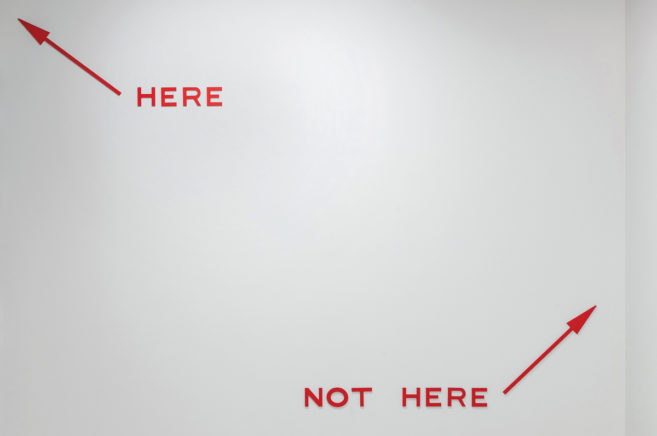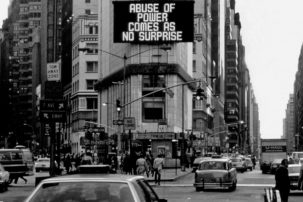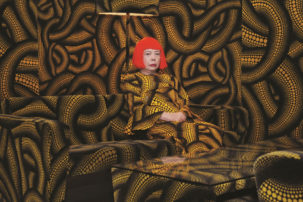This was a big year for decolonizing artistic and curatorial practice in Winnipeg. It was also a great year for feminist practice, and for looking at survival through art. And yet many questions still remain about the ways that art systems need to change in this city, and beyond. Here are some of the lasting impressions.
Decolonizing the Gallery
Throughout 2016, Indigenous and Metis curators and artists thoroughly challenged the dominant paradigm of the contemporary gallery system through an incredible slate of exhibitions, artworks and conversations. At the risk of turning this into a giant list, I want to name a few of them here:
 Amy Malbeuf, The Length of Grief (video still), 2016. Included in “Enendaman | Anminigook” at Ace Art Inc.
Amy Malbeuf, The Length of Grief (video still), 2016. Included in “Enendaman | Anminigook” at Ace Art Inc.
—Niki Little, Indigenous curator-in-residence at Ace Art Inc., reimagined the gallery space as a medicine wheel, connecting each of the four artists in her exhibition “Enendaman | Anminigook” with “one of the four cardinal directions and their corresponding life stage.”
—Duane Linklater and Brian Jungen’s exhibition “Modest Livelihood” at Platform Centre for Photographic and Digital Arts swapped out codified white walls for dark grey, putting a sharp focus on their 50-minute silent film cut from hours of footage from two hunting trips in the Dane-zaa Territory. The work and its set-up in the gallery pushed the conventions of gallery space, art film and ideas of the role of the artist.
—In an action to draw attention to and further the conversation around missing and murdered Indigenous women, Kenneth Lavallee wrapped two neighbouring arts spaces, the Edge Gallery and Mentoring Artists for Women’s Art, in star blanket murals through Synonym Art Consultation’s Wall-to-Wall Festival.
—Urban Shaman Contemporary Aboriginal Art Gallery held a 20th anniversary symposium that delved into the organization’s history, Indigenous new-media art, traditional knowledge and the spiritual well-being of communities through art, and the impact of community projects on artists and communities.
—Plug In Institute of Contemporary Art hosted Wood Land School, led by Duane Linklater and Jaimie Isaac, for their annual Summer Institute. The group’s conceptual focus was Daphne Odjig’s Thunderbird Woman (1973); a lens through which field trips, films, texts and studio time were focused.
—Jaimie Isaac, Winnipeg Art Gallery’s curatorial resident of Indigenous and contemporary art, ended 2016 with “Boarder X,” an audacious and unique exhibition that took over and radically changed the space of the WAG’s cavernous Tyndall stone lobby. As part of the larger exhibition that uses board culture as a way to discuss complex issues of land and Indigenous sovereignty, Isaac opened the cloistered cultural space of the gallery by turning its entryway into a fully functional skate park including a half pipe and scale-model replica of the gallery. By creating a meta-landscape that used the site itself to subvert gallery expectations, inviting Indigenous artists to literally paint over the lobby, Isaac conceptually and physically intervened in the space to make an accessible conversation in which arts and non-arts, Indigenous and non-Indigenous people could participate.
 View of the skate park installation for the opening night of “Boarder X” at the Winnipeg Art Gallery, November 2016. Photo: Leif Norman.
View of the skate park installation for the opening night of “Boarder X” at the Winnipeg Art Gallery, November 2016. Photo: Leif Norman.
Though many of these shows came about through opportunities created by galleries, looking at this list brings up questions of who is really doing the work. How deep an effort needs to be made on the part of organizations to evince real change? Does having artwork and ideas by Indigenous artists sitting on top of an institutional framework that remains unchanged truly do the work that is needed? Is lending exhibition space enough of a move towards decolonizing the gallery? Or do these gestures fall short of the mark if no meaningful transformation is made by the administration towards questioning their own authority or making lasting structural changes to the organizations themselves? Is it progressive because it looks progressive or does it mostly just look good for the institution?
While institutions may have a distance to go in doing the real work of decolonizing the gallery, these artists and curators, radically pushing concepts of site, forms of knowledge and the meaning of artistic authority, are leading the way.
“The great patriarchal barrier”
Let me talk to you man to man, a public lecture by artist Erica Mendritzki, carefully takes apart and examines the subversive work of women artists whose critiques don’t fall into repeated tropes but step outside and complicate concepts of intersectional feminism on their own terms. Clad in a boob shirt and blazer because “it can be tricky, as a female artist, to enter into discussion with what is essentially a 1,000-year-old conversation about hot babes without feeling a little self-conscious, and, perhaps, a little overdressed,” Mendritzki performed this heart-warming examination of the double duty of feminist artists to a packed audience at Mentoring Artists for Women’s Art in February of 2016.
While the ideas being presented—systems of power in art history, the myriad barriers blocking women artists—were not necessarily new to an audience at a feminist arts organization, it was the long-form critical inquiry into the artwork of artists such as Rosemarie Trockel, Louise Lawler and Ana Mendieta that made Mendritzki’s talk so compelling. Especially exciting was the positivity that Mendritzki continually presented throughout, encouraging us to “be like this babe in the 1997 print titled Bibliothek Babylon: we have to be ready to study, to go deep, to think about Trockel’s position in relation to art history, but we also have to be unafraid to use our erotic instincts, to think like a model as well as an artist, and to imagine ourselves wearing strange clothing with confidence and style, leaving our softest parts exposed.”
Luckily, MAWA films all of their lectures and makes them available online, so you can watch the entire talk by going to their website.
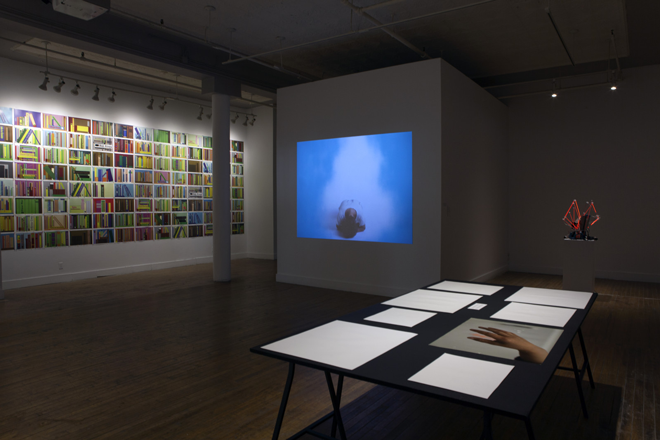 Installation view of “Since Then” at Platform Centre, 2016.
Installation view of “Since Then” at Platform Centre, 2016.
Since Then
Kegan McFadden’s disregard for conventionally defined boundaries in art is apparent when looking at his sprawling curatorial feat, “Since Then,” created for the tenth anniversary of núna (now) – Iceland Canada Art Convergence. With the complex concept of survival as the starting place for McFadden’s curatorial conversation, many conceptual threads were woven between the 22 artists’ works in four galleries (Urban Shaman, Platform, Actual Gallery and Window) criss-crossing Winnipeg’s historic Exchange District.
Works by Indigenous, Metis, Inuit and Icelandic artists spoke across the spaces, revealing unacknowledged cross-cultural connections around colonialism, water and music. Always interested in the possibility for discussion around art, McFadden programmed several points of access around the show, including a participatory performance by Peter Morin, several multi-site walks, and an engaging panel discussion at which the curator urged the importance of continued conversation, not leaving it to those affected to continually speak up but urging “a million voices” to ring out around these issues.
Alexis Kinloch is an arts administrator and founder of Also As Well Too Artist Book Library in Winnipeg.

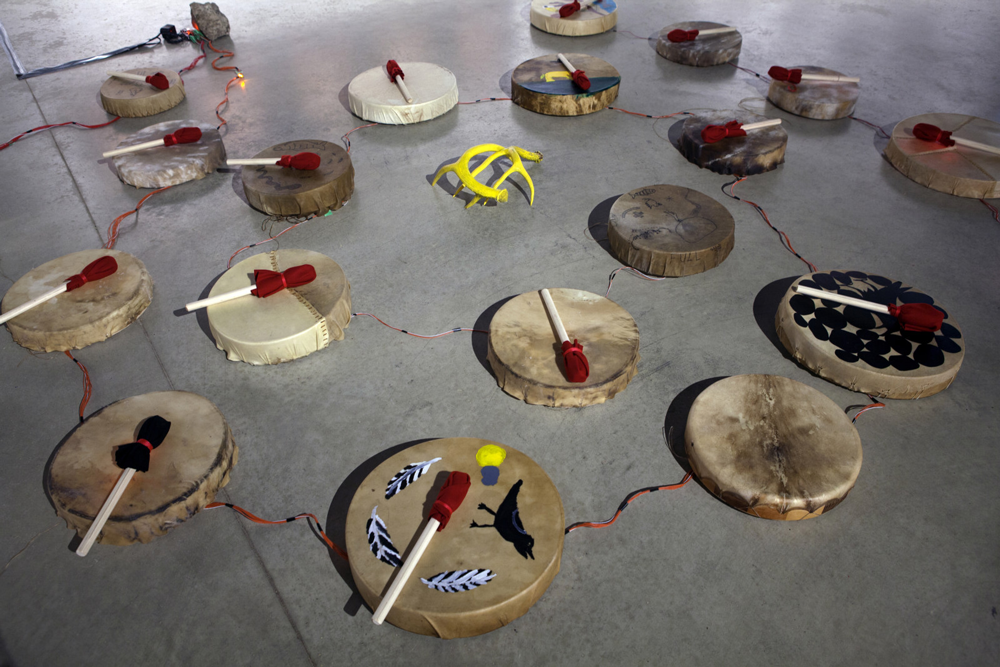 Peter Morin, Experiments in Time Travel, 2015. Installation view as a part of “Since Then,” 2016.
Peter Morin, Experiments in Time Travel, 2015. Installation view as a part of “Since Then,” 2016.
